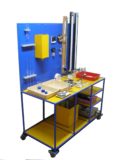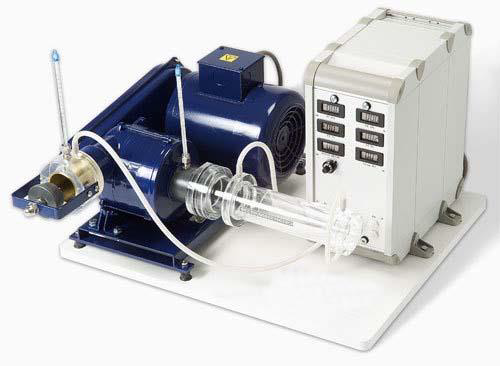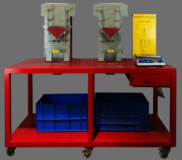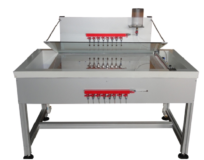Compressible Flow Unit Model FM 79
Home » Products » Compressible Flow Unit Model FM 79
Compressible Flow Unit Model FM 79
Sci-tech Compressible Flow Unit Model FM 079 comprises a single stage air compressor, complete with a test section and a throttling valve, plus an electronics console containing the necessary controls and instrumentation.
The single-stage compressor is driven by an integral three-phase AC motor. The compressor speed can be varied using an advanced torque-vector frequency inverter, which gives stable and accurate speed control plus direct electronic read-out of the torque produced by the motor. The compressor is fitted with an outlet duct incorporating a throttling valve, which allows the flow to be varied independent from compressor speed. The equipment is supplied with a convergent divergent test section, fitted at the compressor inlet, designed to produce Mach-1 velocity at the throat. The duct is fabricated from clear acrylic, enabling the student to see the construction and the profiles. A pressure sensing ring tapping is provided at the inlet, at the throat and at the discharge end of the diffuser. This duct allows all the major concepts of compressible flow to be demonstrated.
The electronics console includes two high range and two low-range differential pressure sensors plus a control for motor speed and displays for the compressor speed, the pressures and the motor torque.
| Size: | 60cm x 45cm x 55cm (LxWxH) |
| Weight: | 35 kg |
Item Description
Features
- Variable-speed air compressor with accurate electronic speed control
- Electronic pressure sensors
- Standard unit includes convergent-divergent duct designed to produce Mach 1 velocity at the throat
- ‘Sci-Cal’ Data logging option available
Sci-tech Compressible Flow Unit Model FM 079 comprises a single stage air compressor, complete with a test section and a throttling valve, plus an electronics console containing the necessary controls and instrumentation. The single-stage compressor is driven by an integral three-phase AC motor. The compressor speed can be varied using an advanced torque-vector frequency inverter, which gives stable and accurate speed control plus direct electronic read-out of the torque produced by the motor. The compressor is fitted with an outlet duct incorporating a throttling valve, which allows the flow to be varied independent from compressor speed. The equipment is supplied with a convergent divergent test section, fitted at the compressor inlet, designed to produce Mach-1 velocity at the throat. The duct is fabricated from clear acrylic, enabling the student to see the construction and the profiles. A pressure sensing ring tapping is provided at the inlet, at the throat and at the discharge end of the diffuser. This duct allows all the major concepts of compressible flow to be demonstrated.
The electronics console includes two high range and two low-range differential pressure sensors plus a control for motor speed and displays for the compressor speed, the pressures and the motor torque.
Technical Specifications
Specifications
investigate flow of compressible fluids
subsonic and transonic air flow
variable speed on the radial fan for adjusting the mass flow
minimized turbulence by drawing in air and optimum arrangement of the measuring objects
transparent measuring objects with connectors for pressure measurement provide insight into the internal structure
measuring nozzle for determining the mass flow
pressure losses in subsonic flow in pipe elbows and various pipe sections
pressure curve at subsonic and transonic nozzle flow
orifice for determining volumetric flow rate by differential pressure measurement
record fan characteristic curve using a throttle valve
digital displays for pressures, velocity and speed
Data Logging with educational software and electronic temperature sensors
Technical Specifications
Radial fan
– max. speed: 34000min-1
– max. volumetric flow rate: 206m³/h
– max. head: 271mbar
– max. power consumption: 1,6kW
Measuring objects
– pipe section: 1m, diameter: 16, 24, 34mm
– 90° pipe elbow
– 2 nozzles, inner diameter: 12…34mm with sudden enlargement
– with gradual enlargement (de Laval nozzle)
– orifice with orifice disks, diameter: 12, 19, 25, 32mm
– throttle valve, diameter: 34mm
Measuring ranges
– speed: 0…99999min-1
– pressure: 1x 0…25mbar, 1x 0…200mbar, 1x 0…1000mbar
– velocity: 0…65m/s
- Optional: ‘Sci-Cal’ Computer Control Software & Interface
‘Sci-Cal’ software & hardware has been designed for use with more than 600 ‘Sci-tech’ trainers. ‘Sci-Cal’ comes in a module that can be fitted or mounted on the Sci-tech trainers very easily.
‘Sci-Cal’ box has 11 inches front HMI interactive panel, inside are i3 processor computer with it’s own hard drive & software processor with 16 to 32 analog and 16 to 32 digital signal data-loggers. The ‘LabVIEW’ processes the input signal with in-built data and formulae to tabulate results for the Sci-tech trainers.
‘Sci-Cal’ box has HDMI output for connection to a projector or an electronic whiteboard or a monitor.
Experiment Capabilities
– pressure losses in pipes and pipe elbows
– flow in convergent/divergent nozzles
– supersonic flow in the de Laval nozzle
– determine the speed of sound in air
– compare calculation methods for incompressible and compressible flow
– use complete continuity equation
– determine mass flow using nozzle and volumetric flow rate using orifice
– record calibration curve for orifice
– record fan characteristic curve at different mass flows and speeds
Required Services
Electric Supply 230 V AC, Single Phase, Earthed.
Model Number
FM 79
See also different:

Several experiments in Fluid Mechanics and Hydraulics which are related to properties of fluids and hydrostatics can be carried out using the Sci-tech Hydrostatic Bench Model MH 48. This is a basic module which provides facilities to develop t [...]



